A Project of the Hudson River Estuary Program
Compiled and edited by Tom Lake, Consulting Naturalist
Love Our NY Lands
State Lands Belong to All of Us
All New Yorkers and visitors should be able to access, enjoy, and feel welcome on state lands. These lands belong to all of us, our families, and our neighbors. While enjoying these shared spaces, be respectful of other visitors. Share trails, treat people with kindness, and leave things as you found them for others to enjoy. All of us have a responsibility to protect State lands for future generations. For more information, visit: https://www.dec.ny.gov/outdoor/119881.html
Overview
It had been an altogether quiet week on the river until the final day when severe thunderstorms, including a tornado, swept across the Hudson Valley. The season-long low salinity in the estuary continued, a product of increased precipitation in the watershed. The autumn migration, in the air and in the water, was beginning to slow.
Highlight of the Week
 11/6 – Peekskill, Westchester County: I’d always heard that cutlip minnow (Exoglossum maxillingua) could be found in certain Westchester streams, but never thought I’d tangle with one on a fly rod. I never suspected that a minnow, reputedly more interested in gouging out the eyes of its neighbors, might also be interested in an old-time Picket Pin wet fly, presented in a classic downstream, quartered retrieve. As gamefish go, I don’t think I’d travel far to capture another, but it was a “life fish” on a fly, and it was fascinating to observe in hand. 11/6 – Peekskill, Westchester County: I’d always heard that cutlip minnow (Exoglossum maxillingua) could be found in certain Westchester streams, but never thought I’d tangle with one on a fly rod. I never suspected that a minnow, reputedly more interested in gouging out the eyes of its neighbors, might also be interested in an old-time Picket Pin wet fly, presented in a classic downstream, quartered retrieve. As gamefish go, I don’t think I’d travel far to capture another, but it was a “life fish” on a fly, and it was fascinating to observe in hand.
The fish measured about six inches, with a broad peduncle, and the most interesting grayish mauve coloration. Maneuvering the fish gently to better observe its “famous” three-part lower jaw, I couldn’t help wondering how I’d never seen one outside of a seine net before. The literature is filled with interesting papers and odd local sightings. I guess the most familiar places can sometimes offer the least familiar experiences. (Photo of cutlip minnow courtesy of Matt Tillett)
- Dave Taft
Natural History Entries
11/6 – Warren County, HRM 245: We set off on a woodland trail that courses along the Hudson River at the Ice Meadows. We passed through stands of white pine and fragrant balsam fir onto the riverside reach. Here the trail was bordered by northern red oak and the golden foliage of American beech. Noisy Canada geese in migration filled up the river as well as the far shoreline—no occupancy. Almost predictable, there was the obligatory snow goose foraging on the far side. This is not an uncommon occurrence where a snow goose loses touch with its flock in migration, for a myriad of reasons, and finds loose kinship with Canada geese.
- Tom Lake, T.R. Jackson, B.J. Jackson, Phyllis Lake
[11/7: Day two on the trail. We had never seen or heard the river so quiet. The geese had left, every one of them, including the snow goose, probably at first light before we took notice. Tom Lake]
 11/6 – Bedford, HRM 35: Among the 42 south-migrating raptors today at the Bedford Audubon Chestnut Ridge Hawkwatch, red-shouldered hawk was high count with 32; sharp-shinned hawk was next with six. Turkey vulture (105) and black vultures (6) combined to dwarf our raptor count. 11/6 – Bedford, HRM 35: Among the 42 south-migrating raptors today at the Bedford Audubon Chestnut Ridge Hawkwatch, red-shouldered hawk was high count with 32; sharp-shinned hawk was next with six. Turkey vulture (105) and black vultures (6) combined to dwarf our raptor count.
The highlight of the day was the three fairly low-flying sandhill cranes that passed directly over the platform heading west. Also seen in flight were common grackle (375), cedar waxwing (177), American robin (134), and red-winged blackbird (25). (Photo of sandhill crane courtesy of Eileen Ambros Stickle)
- Richard Aracil, Hillary Russ, Tony Wilkinson
11/6 – Hook Mountain, HRM 31: We counted 45 south-migrating raptors at the Hook Mountain Hawkwatch today. Red-shouldered hawk was high count with 38; red-tailed hawk was next with three. Turkey vulture (47) and black vulture (7) collectively outnumbered the migrating raptors. Non-raptor migrants were led by American robin (1,500) and common grackle (4,000+).
- Tom Fiore, Raimund Miler, Max Miller
11/7 – Bedford, HRM 35: Among the 13 south-migrating raptors today at the Bedford Audubon Chestnut Ridge Hawkwatch, red-shouldered hawk was high count with seven; sharp-shinned hawk was next with three. A day-long steady trickle of turkey vulture (97) and black vulture (10) dominated our count.
- Richard Aracil
11/8 – Saugerties, HRM 102: The harbor seal made an appearance in early afternoon at the south dike at the mouth of Esopus Creek opposite the Saugerties Lighthouse. My wife, Anna, was inside the lighthouse when she heard the seal vocalize, so she went outside to investigate. The seal also attracted the attention of several visitors on the dock. This was the seal’s Day 825.
- Patrick Landewe
 11/8 – Beacon, HRM 61: It was a very good day of fishing. I caught, admired, and released three channel catfish, two common carp, and a brown bullhead. The channel catfish were the larger males that become active in the fall. The two biggest weighed 5 pounds 13 ounces, and 4 pounds 13 ounces. The carp were reasonably large as well, measuring 18 and 24 inches. (Photo of brown bullhead courtesy of FishBase) 11/8 – Beacon, HRM 61: It was a very good day of fishing. I caught, admired, and released three channel catfish, two common carp, and a brown bullhead. The channel catfish were the larger males that become active in the fall. The two biggest weighed 5 pounds 13 ounces, and 4 pounds 13 ounces. The carp were reasonably large as well, measuring 18 and 24 inches. (Photo of brown bullhead courtesy of FishBase)
- Bill Greene
[Bill Greene, our longtime expert carp and catfish angler, caught his largest channel catfish at Beacon on December 4, 2017. That one measured 29-inches and weighed 9 pounds 9 ounces. Tom Lake]
11/8 – Bedford, HRM 35: Among the 14 south-migrating raptors today at the Bedford Audubon Chestnut Ridge Hawkwatch, sharp-shinned hawk was high count with five; Cooper’s hawk and red-shouldered hawk were next with three each. Turkey vulture (57) and black vulture (nine) dominated the count.
- Richard Aracil, Anastasia Stefanou
11/8 – Hook Mountain, HRM 31: We counted nine south-migrating raptors at the Hook Mountain Hawkwatch today. Red-shouldered hawk was high count with seven; northern harrier was next with two. We also counted 22 black vultures and more than 40 turkey vultures, but none were migrating.
- Ari Weiss, Carl Howard, Raimund Miller, Tom Fiore
11/8 – Yonkers, HRM 18: Our Sarah Lawrence Center for the Urban River at Beczak staff conducted our daily five seine hauls this morning. Our catch was very diverse and included young-of-year Atlantic silverside (75 millimeters (mm)) and striped bass (80 mm), as well as mummichog and white perch. Among crustaceans, were blue crab (20 mm), sand shrimp, and grass shrimp. The river was 57 degrees Fahrenheit (F), salinity was 7.5 parts-per-thousand (ppt), and the dissolved oxygen (DO) was 8.1 parts-per-million (ppm).
- Jason Muller, Sukaina Rashid, Michael Castro
[One inch = 25.4 millimeters(mm). Blue crab measurements (size) are taken in millimeters (mm) point-to-point across their carapace.]
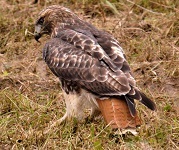 11/9 – Albany County, HRM 143: As I walked along Normanskill Creek today, I watched an immature red-tailed hawk (Buteo jamaicensis) swoop down onto a freshly mown field where it sat in the grass with a small, unidentifiable rodent. Red-tailed hawks are very common, but I am always impressed with the large Buteo “buzzard hawk” shoulders. When they fly, the bright red flash is “tell-tale.” (Photo of red-tailed hawk courtesy of Mario Meier) 11/9 – Albany County, HRM 143: As I walked along Normanskill Creek today, I watched an immature red-tailed hawk (Buteo jamaicensis) swoop down onto a freshly mown field where it sat in the grass with a small, unidentifiable rodent. Red-tailed hawks are very common, but I am always impressed with the large Buteo “buzzard hawk” shoulders. When they fly, the bright red flash is “tell-tale.” (Photo of red-tailed hawk courtesy of Mario Meier)
- Mario Meier
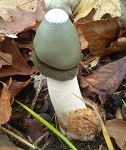 11/9 – Albany County, HRM 140: I came upon a late-fall mushroom, a gray stinkhorn (Phallus impudicus), today near Thompson Lake and the Emma Treadwell Thacher Visitor Center. Stinkhorns emit a foul odor; insects, attracted by the odor to the sticky orifice, carry the spores to other places. (Photo of gray stinkhorn courtesy of Mario Meier) 11/9 – Albany County, HRM 140: I came upon a late-fall mushroom, a gray stinkhorn (Phallus impudicus), today near Thompson Lake and the Emma Treadwell Thacher Visitor Center. Stinkhorns emit a foul odor; insects, attracted by the odor to the sticky orifice, carry the spores to other places. (Photo of gray stinkhorn courtesy of Mario Meier)
- Mario Meier
11/9 – Bedford, HRM 35: Among the eleven south-migrating raptors today at the Bedford Audubon Chestnut Ridge Hawkwatch, sharp-shinned hawk was high count with six; Cooper’s hawk was next with three. It was yet another big day for turkey vulture (54). Cedar waxwing were again seen in numbers (177).
- Richard Aracil
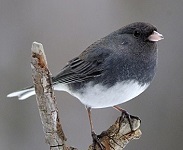 11/9 – Hook Mountain, HRM 31: We counted no (zero) south-migrating raptors at the Hook Mountain Hawkwatch today. In mid-morning, a single turkey vulture floated briefly above Nyack High School, a bit later joined by three comrades patrolling the southwest ridge. At midday, an adult red-tailed hawk appeared in the north and gave half-hearted chase to a passing ring-billed gull. These were the highlights of the morning. 11/9 – Hook Mountain, HRM 31: We counted no (zero) south-migrating raptors at the Hook Mountain Hawkwatch today. In mid-morning, a single turkey vulture floated briefly above Nyack High School, a bit later joined by three comrades patrolling the southwest ridge. At midday, an adult red-tailed hawk appeared in the north and gave half-hearted chase to a passing ring-billed gull. These were the highlights of the morning.
While it was a day without raptors, it was not a day without birds. Not long after sunrise, local passerines were up in the sky and a flock of dark-eyed juncos preened in low bushes on the summit, all appearing to be greeting the sun. This seemed to tempt fate, like swimming with sharks, but perhaps the birds sensed this morning would hold few predators. Among them were red-bellied woodpecker, blue jay, American crow, dark-eyed junco, American robin, Canada goose, mute swan, black-capped chickadee, and white-breasted nuthatch. Butterflies included a single cabbage white, a black swallowtail zooming around the summit seeking battle, and a painted lady. (Photo of dark-eyed junco courtesy of Gerrit Vyn)
- John Phillips
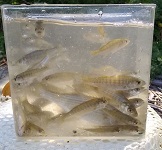 11/9 – Yonkers, HRM 18: Our staff at the Sarah Lawrence Center for the Urban River at Beczak found a school of young-of-year striped bass with our seine today. They averaged 115 mm. Across five hauls of our net, we also caught Atlantic silverside, white perch, blue crabs (90 mm), and four moon jellyfish. The river was 57 degrees F, salinity was 4.8 ppt, and the DO was 8.6 ppm. (Photo of striped bass courtesy of Tom Lake) 11/9 – Yonkers, HRM 18: Our staff at the Sarah Lawrence Center for the Urban River at Beczak found a school of young-of-year striped bass with our seine today. They averaged 115 mm. Across five hauls of our net, we also caught Atlantic silverside, white perch, blue crabs (90 mm), and four moon jellyfish. The river was 57 degrees F, salinity was 4.8 ppt, and the DO was 8.6 ppm. (Photo of striped bass courtesy of Tom Lake)
- Jason Muller, Rachel Lynch, Kiki Quiros, Bella Biane, Ishika Joshi, Rebecca Willson
11/10 – Bedford, HRM 35: Among the 17 south-migrating raptors today at the Bedford Audubon Chestnut Ridge Hawkwatch, red-tailed hawk was high count with six; bald eagle and red-shouldered hawk were next with three each. It was a pretty slow day, except for the highlight in mid-morning, when a young golden eagle went by fairly close to the platform.
-Tait Johansson
11/10 – Hook Mountain, HRM 31: We counted nine south-migrating raptors at the Hook Mountain Hawkwatch today. Sharp-shinned hawk was high count with four; bald eagle was next with two. Both eagles were adults.
- Steve Sachs, Tom Fiore
11/10 – Yonkers, HRM 18: Once again today, our staff at the Sarah Lawrence Center for the Urban River at Beczak netted and released a school of young-of-year striped bass (95 mm). Other fishes in our seine were Atlantic silverside, mummichog, and white perch. Blue crabs were still around as was a single moon jellyfish. The river was 57 degrees F, salinity was 2.91 ppt, and the DO was 9.3 ppm.
- Jason Muller, Raven Vance
11/11 – Bedford, HRM 35: Among the 29 south-migrating raptors today at the Bedford Audubon Chestnut Ridge Hawkwatch, red-shouldered hawk was high count with eleven; sharp-shinned hawk was next with ten. The highlight was a distant golden eagle seen flying low to our south before dipping below the tree line. We are still hoping for some big, red-shouldered hawk days like we had last year.
Turkey vulture (33) outperformed the raptors today. Other non-raptor migrants included common grackle (680), American robin (828), and common loon (2).
- Richard Aracil
11/11 – Hook Mountain, HRM 31: We counted 32 south-migrating raptors at the Hook Mountain Hawkwatch today. Red-shouldered hawk was high count with 19; red-tailed hawk was next with four. Turkey vulture (10) continued their steady move.
- Vince Plogar, Eugene Gardner
11/11 – Yonkers, HRM 18: This week’s catch at the Sarah Lawrence Center for the Urban River at Beczak was all about young-of-year striped bass (80-120 mm). We had very good seine catches Monday through Wednesday and finished the week with 34. Also, of note today was 59 mummichogs, seven Atlantic silverside (75 mm), and some grass (shore) shrimp. The river was 54.5 degrees F, salinity was 2.84 ppt, and the DO was 9.53 ppm.
- Jason Muller, Diane McKay
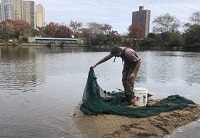 11/11 – Hastings-on-Hudson to Manhattan, HRM 21-12: On a perfect sunny day for seining the lower Hudson River, we began at Hastings-on-Hudson’s ’s MacEachron Park. Four hauls of our seine through very thick mud yielded many laughs as well as 23 young-of-year striped bass, two mummichogs, and four dime-sized blue crabs. The water temperature was 55 degrees F, and the salinity was 6.0 ppt. 11/11 – Hastings-on-Hudson to Manhattan, HRM 21-12: On a perfect sunny day for seining the lower Hudson River, we began at Hastings-on-Hudson’s ’s MacEachron Park. Four hauls of our seine through very thick mud yielded many laughs as well as 23 young-of-year striped bass, two mummichogs, and four dime-sized blue crabs. The water temperature was 55 degrees F, and the salinity was 6.0 ppt.
Our next stop heading downriver was the Harlem River tidal basin at Inwood Park at the northern tip of Manhattan, beneath the profile of the Spuyten Duyvil Bridge. A half dozen hauls along a thin strip of Phragmites vegetation gave us four Atlantic silverside, a dozen smaller blue crabs, one white perch, two young-of-year striped bass, and many hundreds of mummichogs (Fundulus heteroclitus) squirming in the mud and submerged autumn leaves. Here, the salinity was 8.0 ppt.
Most interesting was the correlation of habitat type and fish abundance. Hastings, with a more typical “beach” of sand and mud, had many more striped bass than mummichogs; the vegetated fringe of the Inwood Basin dramatically flipped that ratio. (Photo of seining at Inwood Park courtesy of Chris Bowser)
- Chris Bowser, McKenna Koons, Derek McGee, Ranger Blaisley
*** Fish of the Week ***
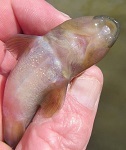 11/12 – Hudson River Watershed: Fish-of-the-Week for Week 146 is the cutlip minnow (Exoglossum maxillingua) number 44 (of 236) on our watershed list of fishes. If you would like a copy of our list, e-mail - trlake7@aol.com. 11/12 – Hudson River Watershed: Fish-of-the-Week for Week 146 is the cutlip minnow (Exoglossum maxillingua) number 44 (of 236) on our watershed list of fishes. If you would like a copy of our list, e-mail - trlake7@aol.com.
The cutlip minnow is one of 32 carps and minnows (Cyprinidae) in the watershed, representing nearly fourteen percent of the 236 species. They are small, rarely more the 120 mm long. The cutlip minnow is native to the Northeast United States and is found in small clear-water streams ranging from the Saint Lawrence River watershed south to the Carolinas.
C. Lavett Smith describes them as “drab, with subdued colors, heavy-bodied, nearly terete in cross-section, an all-together ‘somber fish.’” Perhaps their most notable behavior is their predilection for plucking out the eyes of other fishes. The center lobe of the cutlip minnow’s lower jaw is sharply hardened. They use it, not unlike a scalpel, to core out fish eyes. When you come across a one-eyed white sucker, yellow perch, or goldfish, you can be quite certain that there are cutlip minnows in the area. This is a life history that could have been devised by Stephen King. (Photo of cutlip minnow courtesy of Matt Tillett)
-Tom Lake
[The eye-plucking behavior is largely aggression and seems to only appear during high densities of cutlip minnow. Predators often aim for the head to disable a prey fish and the eye is a good indicator of where the head is. Fish have developed tail spots in correlation with eye stripes to deflect predators toward the tail. The eye stripe camouflages the real eye, and the tail spot is often highly contrasted to make it a more appealing target. A predator going for the tail is less likely to succeed. I once took a class out collecting in Stony Creek. The creek had mostly dried up, but we found a pool where fish were trapped in high densities including cutlip minnows. Sure enough, several bluegills were missing an eye. Bob Schmidt]
11/12 – Hudson River Estuary: An intense storm in the Upper Midwest sent a strong cold front through the Northeast setting off strong to severe thunderstorms. Brief but heavy rain, hail, and strong winds swept up the Hudson Valley and on into New England from southwest to northeast. Trees were uprooted and power lines were down in some areas along with tornado warnings. Small craft advisories were issued for the Hudson River.
- National Weather Service
11/12 – Millbrook, HRM 82: Severe weather in the mid-Hudson Valley resulted in an EF1- rated tornado, with estimated maximum wind speed of 90 miles-per-hour, touching down around 11:15 AM near Millbrook in the town of Washington. The tornado followed a 2.5-mile path with an estimated width of 100 to 200 yards. While numerous trees were damaged, and falling trees damaged a number of homes and cars, no injuries or deaths were reported.
- National Weather Service
11/12 – Croton-on-Hudson, HRM 35: The air temperature reached 65 degrees Fahrenheit today establishing a new record high for the date.
- National Weather Service

Autumn 2021 Natural History Programs and Events
Webinar: Protecting Wildlife Habitat through Land Use Planning
Wednesday, December 7, 1:00-2:30 PM
(Register here)
Our presenters will draw on two decades of socioecological research experience to discuss best practices for protecting wildlife and habitat through conservation development. They will share regional studies that demonstrate why such practices are needed, the type and quality of existing protection mechanisms in Northeast land-use codes and ordinances, factors associated with success or failure to implement conservation design principles, and critical areas for future research.
Presenters:
Dr. Michale Glennon, Science Director at Paul Smith's College Adirondack Watershed Institute Dr. Heidi Kretser, Senior Conservation Social Scientist at the Wildlife Conservation Society
Funding Available for Hudson River Fish Advisory Outreach Initiative
Fish are an important part of a healthy diet, containing high quality protein, essential nutrients, healthy fish oils, and low saturated fat. However, fish in some New York water bodies contain chemicals at levels that may be harmful to health. To help people make healthier choices about which fish to eat, the New York State Department of Health (NYSDOH) issues advice about eating fish you catch. One of the water bodies for which NYSDOH has fish advisories is the Hudson River.
The Hudson River Fish Advisory Outreach Project’s goal is for all Hudson fish and blue crab consumers know about, understand, and follow the NYSDOH advisories. To this end, Health Research, Inc. and NYSDOH announce the availability of a total of $90,000 per year to develop partnerships with local groups. Applications for funding must serve populations that fish or are likely to eat fish from the Hudson River in Albany, Bronx, Columbia, Dutchess, Greene, New York, Orange, Putnam, Rensselaer, Rockland, Saratoga, Ulster, Washington, and/or Westchester counties. Priority audiences are women under 50 (childbearing years), families with children under 15, minority, low-income, low-literacy, and limited-English proficiency individuals.
Maximum awards are for $15,000 a year. Government entities and community based not-for-profit organizations are eligible to apply. Applications are due December 1, 2021. For details, visit the project’s Request for Applications website.
- Audrey Vangenechten, NYS Department of Health
Hudson River Miles
The Hudson is measured north from Hudson River Mile 0 at the Battery at the southern tip of Manhattan. The George Washington Bridge is at HRM 12, the Tappan Zee 28, Bear Mountain 47, Beacon-Newburgh 62, Mid-Hudson 75, Kingston-Rhinecliff 95, Rip Van Winkle 114, and the Federal Dam at Troy, the head of tidewater, at 153. The tidal section of the Hudson constitutes a bit less than half the total distance – 315 miles – from Lake Tear of the Clouds to the Battery. Entries from points east and west in the watershed reference the corresponding river mile on the mainstem.
To Contribute Your Observations or to Subscribe
The Hudson River Almanac is compiled and edited by Tom Lake and emailed weekly by DEC's Hudson River Estuary Program. Share your observations by e-mailing them to trlake7@aol.com. To subscribe to the Almanac (or to unsubscribe), use the links on DEC's Hudson River Almanac or DEC Delivers web pages.
Discover New York State
The Conservationist, the award-winning, advertisement-free magazine focusing on New York State's great outdoors and natural resources. The Conservationist features stunning photography, informative articles and around-the-state coverage. Visit The Conservationist webpage for more information.
Useful Links
National Oceanic and Atmospheric Administration online tide and tidal current predictions are invaluable when planning Hudson River field trips. For real-time information on Hudson River tides, weather and water conditions from sixteen monitoring stations, visit the Hudson River Environmental Conditions Observing System website.
DEC's Smartphone app for iPhone and Android is now available at: New York Fishing, Hunting & Wildlife App.
|


 11/6 – Peekskill, Westchester County: I’d always heard that cutlip minnow (Exoglossum maxillingua) could be found in certain Westchester streams, but never thought I’d tangle with one on a fly rod. I never suspected that a minnow, reputedly more interested in gouging out the eyes of its neighbors, might also be interested in an old-time Picket Pin wet fly, presented in a classic downstream, quartered retrieve. As gamefish go, I don’t think I’d travel far to capture another, but it was a “life fish” on a fly, and it was fascinating to observe in hand.
11/6 – Peekskill, Westchester County: I’d always heard that cutlip minnow (Exoglossum maxillingua) could be found in certain Westchester streams, but never thought I’d tangle with one on a fly rod. I never suspected that a minnow, reputedly more interested in gouging out the eyes of its neighbors, might also be interested in an old-time Picket Pin wet fly, presented in a classic downstream, quartered retrieve. As gamefish go, I don’t think I’d travel far to capture another, but it was a “life fish” on a fly, and it was fascinating to observe in hand.  11/6 – Bedford, HRM 35: Among the 42 south-migrating raptors today at the Bedford Audubon Chestnut Ridge Hawkwatch, red-shouldered hawk was high count with 32; sharp-shinned hawk was next with six. Turkey vulture (105) and black vultures (6) combined to dwarf our raptor count.
11/6 – Bedford, HRM 35: Among the 42 south-migrating raptors today at the Bedford Audubon Chestnut Ridge Hawkwatch, red-shouldered hawk was high count with 32; sharp-shinned hawk was next with six. Turkey vulture (105) and black vultures (6) combined to dwarf our raptor count.  11/8 – Beacon, HRM 61: It was a very good day of fishing. I caught, admired, and released three channel catfish, two common carp, and a brown bullhead. The channel catfish were the larger males that become active in the fall. The two biggest weighed 5 pounds 13 ounces, and 4 pounds 13 ounces. The carp were reasonably large as well, measuring 18 and 24 inches. (Photo of brown bullhead courtesy of FishBase)
11/8 – Beacon, HRM 61: It was a very good day of fishing. I caught, admired, and released three channel catfish, two common carp, and a brown bullhead. The channel catfish were the larger males that become active in the fall. The two biggest weighed 5 pounds 13 ounces, and 4 pounds 13 ounces. The carp were reasonably large as well, measuring 18 and 24 inches. (Photo of brown bullhead courtesy of FishBase) 11/9 – Albany County, HRM 143: As I walked along Normanskill Creek today, I watched an immature red-tailed hawk (Buteo jamaicensis) swoop down onto a freshly mown field where it sat in the grass with a small, unidentifiable rodent. Red-tailed hawks are very common, but I am always impressed with the large Buteo “buzzard hawk” shoulders. When they fly, the bright red flash is “tell-tale.” (Photo of red-tailed hawk courtesy of Mario Meier)
11/9 – Albany County, HRM 143: As I walked along Normanskill Creek today, I watched an immature red-tailed hawk (Buteo jamaicensis) swoop down onto a freshly mown field where it sat in the grass with a small, unidentifiable rodent. Red-tailed hawks are very common, but I am always impressed with the large Buteo “buzzard hawk” shoulders. When they fly, the bright red flash is “tell-tale.” (Photo of red-tailed hawk courtesy of Mario Meier) 11/9 – Albany County, HRM 140: I came upon a late-fall mushroom, a gray stinkhorn (Phallus impudicus), today near Thompson Lake and the Emma Treadwell Thacher Visitor Center. Stinkhorns emit a foul odor; insects, attracted by the odor to the sticky orifice, carry the spores to other places. (Photo of gray stinkhorn courtesy of Mario Meier)
11/9 – Albany County, HRM 140: I came upon a late-fall mushroom, a gray stinkhorn (Phallus impudicus), today near Thompson Lake and the Emma Treadwell Thacher Visitor Center. Stinkhorns emit a foul odor; insects, attracted by the odor to the sticky orifice, carry the spores to other places. (Photo of gray stinkhorn courtesy of Mario Meier) 11/9 – Hook Mountain, HRM 31: We counted no (zero) south-migrating raptors at the Hook Mountain Hawkwatch today. In mid-morning, a single turkey vulture floated briefly above Nyack High School, a bit later joined by three comrades patrolling the southwest ridge. At midday, an adult red-tailed hawk appeared in the north and gave half-hearted chase to a passing ring-billed gull. These were the highlights of the morning.
11/9 – Hook Mountain, HRM 31: We counted no (zero) south-migrating raptors at the Hook Mountain Hawkwatch today. In mid-morning, a single turkey vulture floated briefly above Nyack High School, a bit later joined by three comrades patrolling the southwest ridge. At midday, an adult red-tailed hawk appeared in the north and gave half-hearted chase to a passing ring-billed gull. These were the highlights of the morning.  11/9 – Yonkers, HRM 18: Our staff at the Sarah Lawrence Center for the Urban River at Beczak found a school of young-of-year striped bass with our seine today. They averaged 115 mm. Across five hauls of our net, we also caught Atlantic silverside, white perch, blue crabs (90 mm), and four moon jellyfish. The river was 57 degrees F, salinity was 4.8 ppt, and the DO was 8.6 ppm. (Photo of striped bass courtesy of Tom Lake)
11/9 – Yonkers, HRM 18: Our staff at the Sarah Lawrence Center for the Urban River at Beczak found a school of young-of-year striped bass with our seine today. They averaged 115 mm. Across five hauls of our net, we also caught Atlantic silverside, white perch, blue crabs (90 mm), and four moon jellyfish. The river was 57 degrees F, salinity was 4.8 ppt, and the DO was 8.6 ppm. (Photo of striped bass courtesy of Tom Lake) 11/11 – Hastings-on-Hudson to Manhattan, HRM 21-12: On a perfect sunny day for seining the lower Hudson River, we began at Hastings-on-Hudson’s ’s MacEachron Park. Four hauls of our seine through very thick mud yielded many laughs as well as 23 young-of-year striped bass, two mummichogs, and four dime-sized blue crabs. The water temperature was 55 degrees F, and the salinity was 6.0 ppt.
11/11 – Hastings-on-Hudson to Manhattan, HRM 21-12: On a perfect sunny day for seining the lower Hudson River, we began at Hastings-on-Hudson’s ’s MacEachron Park. Four hauls of our seine through very thick mud yielded many laughs as well as 23 young-of-year striped bass, two mummichogs, and four dime-sized blue crabs. The water temperature was 55 degrees F, and the salinity was 6.0 ppt.  11/12 – Hudson River Watershed: Fish-of-the-Week for Week 146 is the cutlip minnow (Exoglossum maxillingua) number 44 (of 236) on our watershed list of fishes. If you would like a copy of our list, e-mail -
11/12 – Hudson River Watershed: Fish-of-the-Week for Week 146 is the cutlip minnow (Exoglossum maxillingua) number 44 (of 236) on our watershed list of fishes. If you would like a copy of our list, e-mail - 